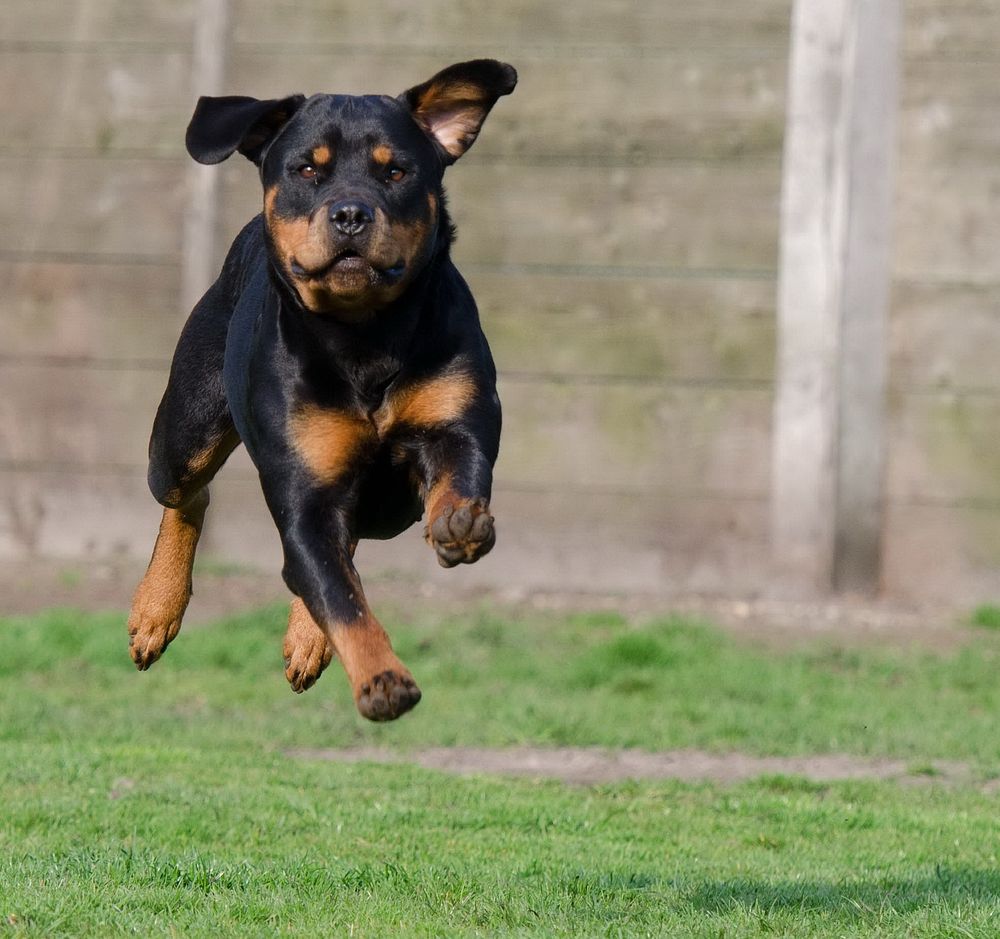The German Shepherd Rottweiler Mix, often referred to as the “Shepweiler“, is a remarkable hybrid breed that combines the best traits of its parent breeds—the intelligent German Shepherd and the powerful Rottweiler.
This mix is celebrated for its impressive physical characteristics, blending the muscular build of a Rottweiler with the agility and sleek coat of a German Shepherd.
German Shepherd Rottweiler Mix Overview
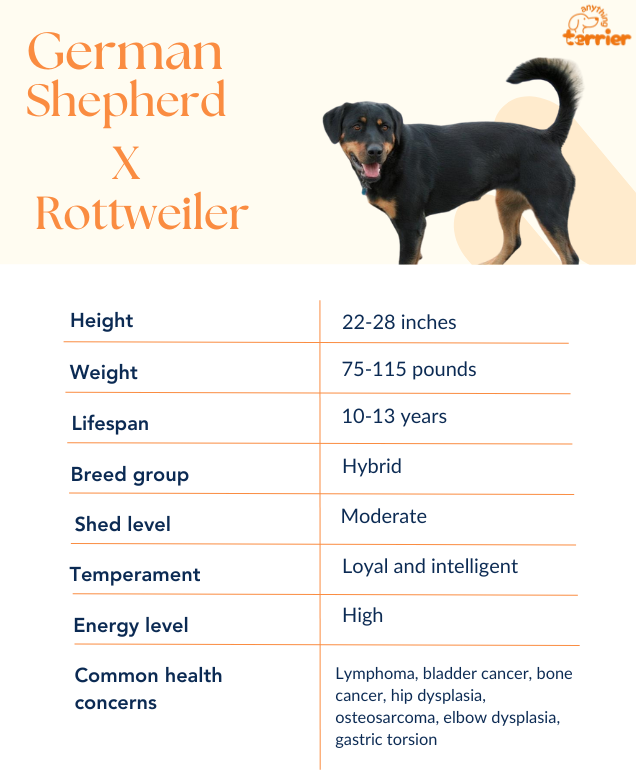
Known for their loyalty, strength, and sharp intellect, these dogs are a favorite among active families and individuals seeking a devoted and protective companion.
Whether as a puppy or a fully grown adult, this hybrid boasts unique traits that make it both a loving family pet and an effective working dog.
In addition to their striking appearance, Shepweilers are admired for their well-rounded temperament and versatility.
They typically inherit the protective instincts of the Rottweiler and the trainability of the German Shepherd, making them highly adaptable to various roles, from guardians to therapy dogs.
However, potential owners should be mindful of their health needs, as this hybrid may be prone to common conditions found in its parent breeds, such as hip dysplasia.
Early training, proper socialization, and routine veterinary care are essential to ensuring that these dogs thrive, showcasing their remarkable characteristics and deep bond with their owners.
Caring for German Shepherd Rottweiler Mix
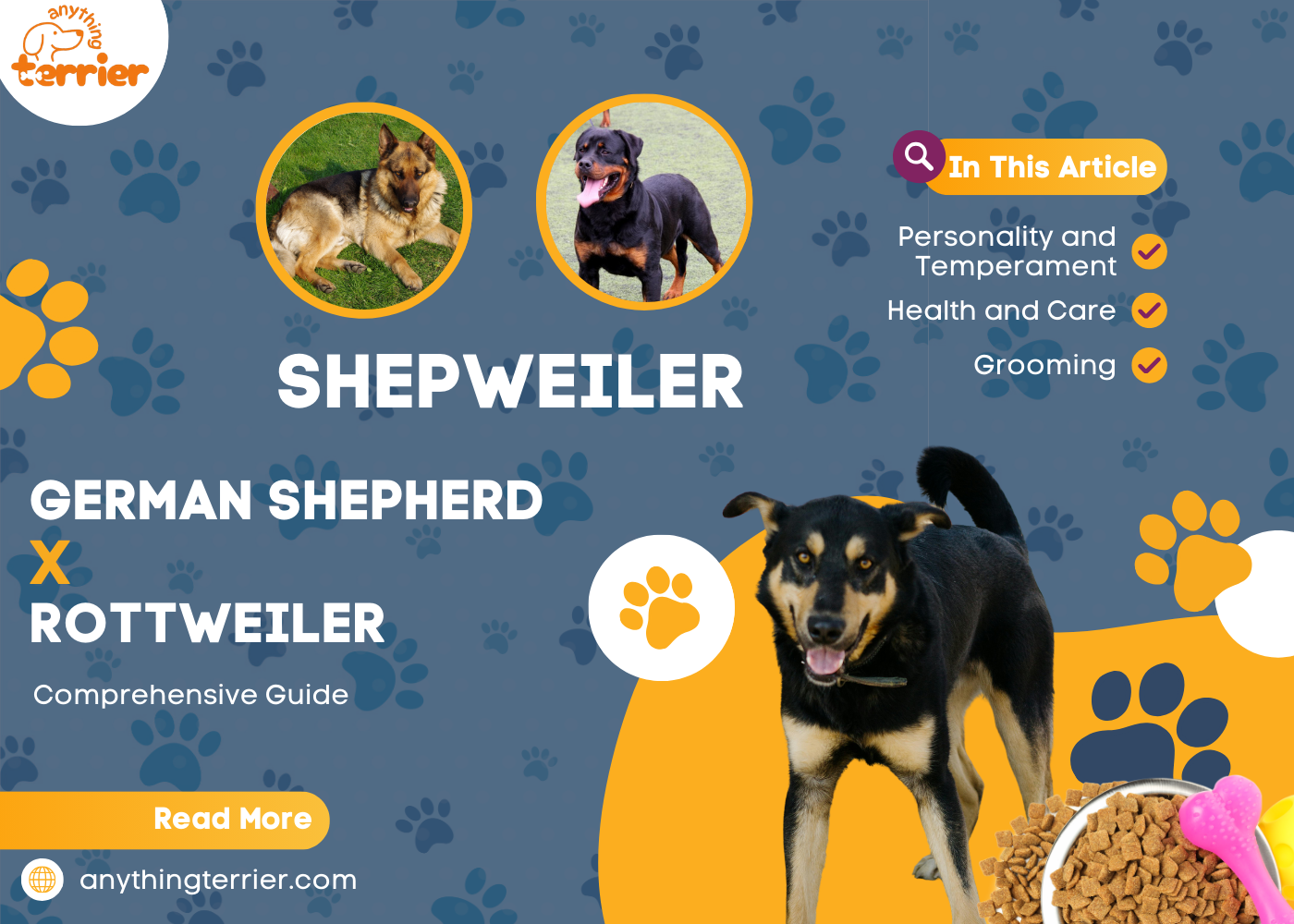
Caring for a German Shepherd Rottweiler Mix requires attention to their physical needs and active temperament. As a full-grown hybrid, their size can range from medium to large, with an average weight between 70 to 115 pounds and a height of 22 to 27 inches at the shoulder.
Their athletic build and strength, inherited from both the German Shepherd and Rottweiler, mean they thrive in homes that provide ample space for movement and exercise.
Regular walks, play sessions, and mental stimulation are essential to keep these energetic dogs happy and healthy.
This mix also has a relatively long life expectancy for a large breed, typically ranging from 9 to 13 years. To ensure a healthy and fulfilling life, it’s important to provide a well-balanced diet tailored to their size and weight, along with routine veterinary checkups.
Like other hybrids, such as the German Shepherd mixed with a Rottweiler, they may be prone to certain health issues, including hip dysplasia and joint problems, so early preventive care is key.
Training and socialization from a young age also play a crucial role in managing their natural protective instincts.
The German Shepherd Rottweiler Mix is known for its loyal and intelligent temperament, making them excellent family pets and working dogs.
Their size and strength require consistent training and leadership, but with proper care and attention, they form strong bonds with their owners.
Whether as a playful companion or a reliable protector, this mix brings together the best traits of both parent breeds, making them a versatile and rewarding choice for experienced dog owners.
German Shepherd Rottweiler Mix Health Issues
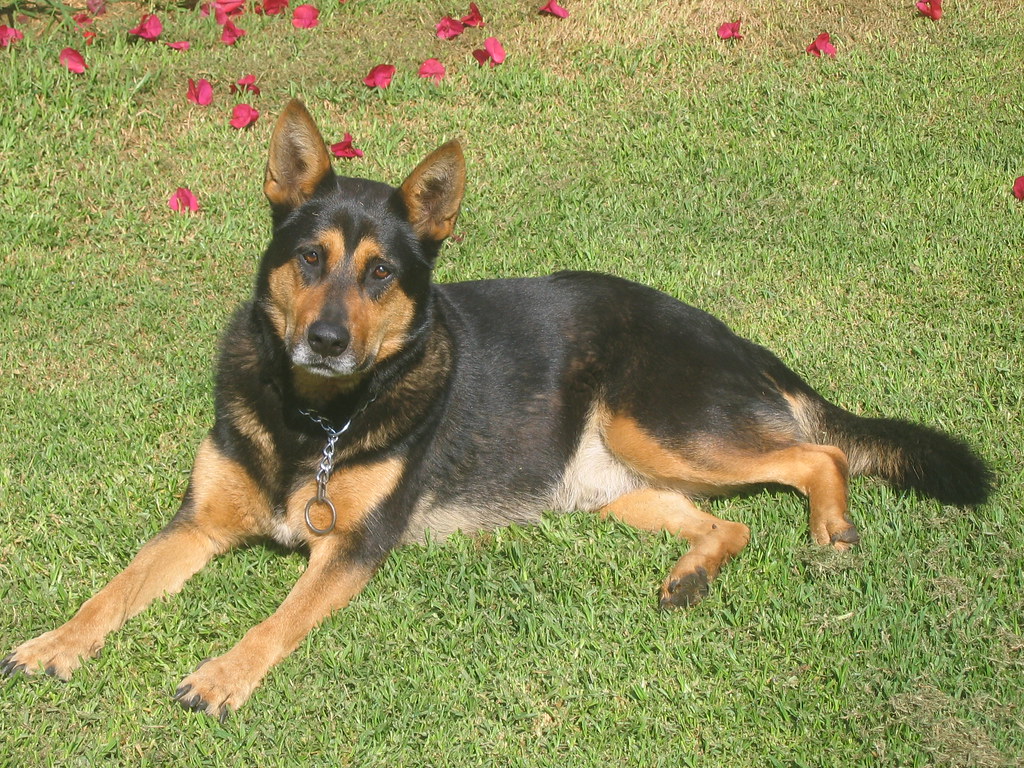
The German Shepherd Rottweiler Mix, a powerful and intelligent hybrid, combines traits from two highly respected breeds.
However, like their parent breeds, these dogs may be predisposed to specific health conditions.
Understanding and addressing potential health issues early can help owners provide the best care for their companion.
Below is an in-depth look at some of the most common health concerns affecting this hybrid.
1. Lymphoma
Lymphoma is a type of cancer affecting the lymphatic system, a critical part of the immune system.
German Shepherd Rottweiler Mixes may show symptoms such as swollen lymph nodes, lethargy, weight loss, or lack of appetite.
Early detection through regular vet checkups is crucial. Treatment options include chemotherapy, which can improve quality of life and potentially extend survival.
2. Bladder Cancer
This mix can also be at risk of bladder cancer, specifically Transitional Cell Carcinoma (TCC).
Symptoms include difficulty urinating, blood in the urine, and frequent urination with little output. Bladder cancer is often diagnosed through ultrasounds or biopsies.
Treatments may include surgery, chemotherapy, or non-invasive therapies, depending on the stage of the disease.
3. Cancer of the Blood Vessels (Hemangiosarcoma)
Hemangiosarcoma is an aggressive cancer that develops in blood vessels, often affecting the spleen or heart.
This condition is common in both German Shepherds and Rottweilers, making the mix prone to it. Symptoms include sudden weakness, collapse, or pale gums due to internal bleeding.
While treatment options like surgery and chemotherapy exist, the prognosis is often guarded.
4. Bone Cancer (Osteosarcoma)
Osteosarcoma is a malignant bone tumor commonly seen in large breeds, including the German Shepherd Rottweiler Mix.
Symptoms include lameness, swelling, and noticeable pain in the affected limb.
Early diagnosis is critical, and treatments may involve amputation of the affected limb and chemotherapy.
Regular monitoring for any signs of lameness or discomfort is vital for early intervention.
5. Hip Dysplasia
Hip dysplasia is a genetic condition where the hip joint doesn’t develop properly, leading to arthritis and mobility issues over time.
This condition is prevalent in both parent breeds and can manifest as difficulty standing, reluctance to exercise, or limping.
Maintaining a healthy weight, providing joint supplements, and considering surgical options for severe cases can help manage this condition.
6. Osteosarcoma
Osteosarcoma, in addition to being a primary bone cancer, may cause pain and structural damage in weight-bearing bones.
Affected dogs often exhibit noticeable swelling and severe limping.
Owners should look for early signs and consult a veterinarian immediately if these symptoms arise.
Advanced imaging, like X-rays or MRIs, is essential for accurate diagnosis.
7. Elbow Dysplasia
Elbow dysplasia occurs when there is an abnormal development in the elbow joint, leading to pain and stiffness.
Symptoms include limping on the front limbs, swelling, and reluctance to move.
This condition can be managed with weight control, physical therapy, anti-inflammatory medications, or surgery in severe cases.
8. Gastric Torsion (Bloat)
Gastric torsion, or bloat, is a life-threatening condition where the stomach twists, trapping gas and cutting off blood flow.
Large, deep-chested breeds like the German Shepherd Rottweiler Mix are at high risk. Symptoms include a swollen abdomen, unproductive vomiting, restlessness, and difficulty breathing.
Immediate emergency treatment is required, often involving surgery. Preventive measures include feeding smaller meals throughout the day and avoiding vigorous activity after eating.
Behavior and Training Tips for German Shepherd Rottweiler Mix
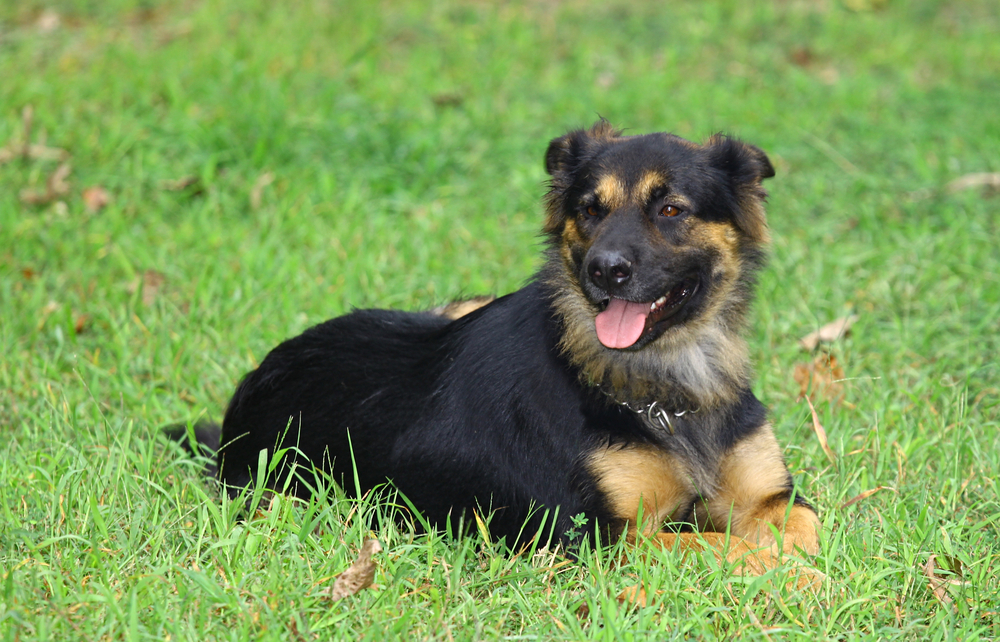
German Shepherd Rottweiler Mix Personality and Temperament
The German Shepherd Rottweiler Mix is known for its bold, confident, and protective nature. These dogs are highly loyal to their families and often form strong bonds with their owners.
Their temperament is a mix of the Rottweiler’s guarding instincts and the German Shepherd’s working-dog drive, making them naturally watchful and alert.
While generally friendly and playful with proper socialization, they may exhibit caution around strangers, making early training essential to avoid overly protective behaviors.
This hybrid is also highly intelligent and eager to learn, traits that make them excellent candidates for advanced obedience and working roles.
However, their strong will requires consistent leadership and positive reinforcement to prevent stubborn tendencies.
A well-trained Shepweiler thrives in an environment where they can feel purposeful and engaged.
German Shepherd Rottweiler Mix Behavior
Due to their energetic and curious nature, German Shepherd Rottweiler Mixes are known for being active and adventurous.
Without adequate mental and physical stimulation, they may develop undesirable behaviors such as chewing, digging, or excessive barking.
Their protective instincts can sometimes lead to territorial tendencies, so early exposure to various environments, people, and animals is critical for promoting balanced behavior.
This mix may also display herding instincts inherited from their German Shepherd lineage or a strong desire to guard, a trait from their Rottweiler side.
While these behaviors can be beneficial in certain settings, proper management and training are essential to ensure they do not become problematic.
German Shepherd Rottweiler Mix Training Tips
- Start Early: Begin training as soon as you bring your puppy home. Focus on socialization, exposing them to new people, pets, and environments to build confidence and reduce fear or aggression.
- Positive Reinforcement: Reward-based training is highly effective for this intelligent breed. Use treats, praise, and play to reinforce good behavior and build trust.
- Consistency is Key: Be firm but fair, maintaining clear and consistent commands. Avoid harsh punishments, as this can lead to fear or distrust in such a sensitive breed.
- Mental Stimulation: Incorporate puzzle toys, obedience challenges, or scent work into their routine to keep their sharp minds engaged. This can help curb boredom-related behaviors.
- Leash Training: Given their size and strength, leash training is crucial. Teach them to walk calmly by your side to prevent pulling or lunging behaviors.
- Guarding Instincts: Manage guarding tendencies by teaching commands such as “leave it” or “stay” and practicing scenarios where they can calmly observe strangers.
Fun Activities
- Agility Training
- Fetch and Frisbee
- Hiking Adventures
- Interactive Games
- Swimming
How to Feed a German Shepherd Rottweiler Mix
Feeding a German Shepherd Rottweiler Mix requires careful consideration of their size, activity level, and nutritional needs.
These hybrids are typically large, muscular dogs with high energy levels, making a diet rich in quality protein essential for muscle maintenance and overall health.
Look for dog foods that list real meat as the first ingredient, such as chicken, beef, or fish. Additionally, ensure the diet includes healthy fats for energy, omega-3 fatty acids for a shiny coat, and carbohydrates from wholesome sources like sweet potatoes or brown rice to fuel their active lifestyle.
Divide their meals into two or three servings per day to prevent overeating and reduce the risk of gastric torsion (bloat), a condition common in large breeds. Always provide fresh water and avoid free-feeding, as this can lead to obesity.
Monitor their weight and adjust portions as necessary based on their activity level and age. Puppies have higher calorie and nutrient demands, so ensure they’re on a diet formulated for large-breed puppies to support healthy growth and bone development.
How Much Should You Feed a Mini German Shepherd Rottweiler Mix?
A mini German Shepherd Rottweiler Mix, typically smaller than the standard breed mix, still requires a well-balanced diet tailored to their size and activity level.
On average, mini hybrids may weigh between 30 to 50 pounds, so their daily calorie intake will be slightly less than their larger counterparts.
Feed them approximately 2 to 3 cups of high-quality dog food daily, divided into two meals.
Since minis may still have the same energy and muscular demands as larger dogs, opt for nutrient-dense foods.
Avoid overfeeding, as even smaller dogs can become prone to weight gain, which can exacerbate joint issues like hip or elbow dysplasia.
Consult your veterinarian for specific portion sizes, as calorie needs can vary depending on age, activity level, and overall health.
Nutritional Tips for German Shepherd Rottweiler Mix
- Protein-Rich Diet: Protein is the foundation of their diet, supporting their active lifestyle and muscle maintenance. Aim for a food that contains at least 22-26% protein for adult dogs.
- Healthy Fats: Include sources of omega-3 and omega-6 fatty acids, such as fish oil or flaxseed, to promote joint health and a glossy coat.
- Joint Support: As this hybrid is prone to hip and elbow dysplasia, look for foods that include glucosamine and chondroitin to maintain joint health.
- Weight Management: Obesity can exacerbate common health issues like joint problems and bloat. Monitor calorie intake and ensure they maintain an ideal body weight.
- Avoid Fillers: Stay away from dog foods with excessive fillers like corn, soy, or by-products, as these provide little nutritional value.
- Age-Appropriate Diet: Feed puppies specially formulated large-breed puppy food to ensure proper growth, and transition to an adult formula as they reach maturity (around 12 to 18 months).
- Hydration: Always ensure they have access to clean, fresh water, especially after exercise or during hot weather.
German Shepherd Rottweiler Mix Grooming Guide
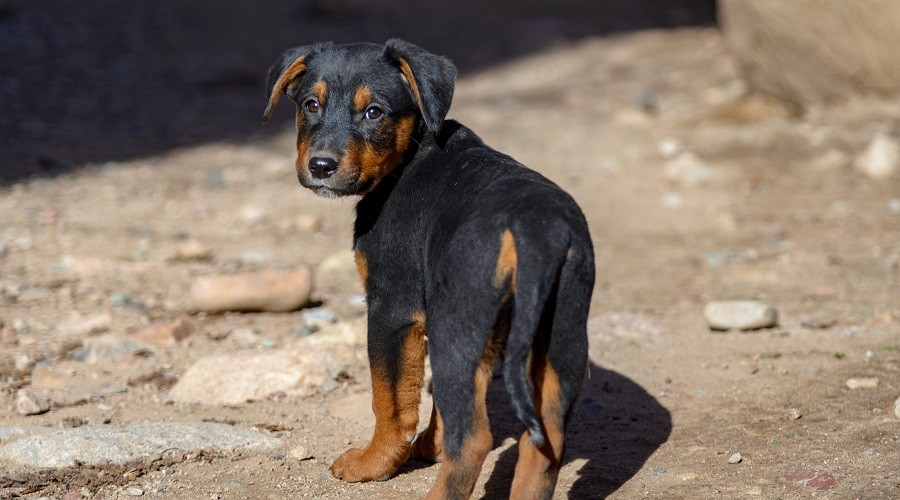
Skin Care
The German Shepherd Rottweiler Mix is prone to certain skin conditions, such as allergies or dry skin. Regularly inspect their skin for redness, flaking, or signs of irritation.
Use hypoallergenic dog shampoos designed for sensitive skin to prevent dryness or allergic reactions. Bathe them every 6-8 weeks or as needed to avoid stripping the natural oils that keep their skin healthy.
Moisturizing sprays or omega-3 fatty acid supplements, such as fish oil, can help maintain skin hydration and reduce itchiness.
Monitor for signs of hot spots—areas of inflamed, itchy skin that can lead to infection. If you notice persistent scratching, consult a veterinarian to address underlying causes like allergies or parasites.
Coat Care
The dense coat of a German Shepherd Rottweiler Mix often sheds moderately to heavily, especially during seasonal changes.
Weekly brushing with a slicker brush or de-shedding tool helps manage shedding and keeps their coat looking healthy.
Regular brushing also stimulates circulation and distributes natural oils, promoting a shiny coat.
During shedding seasons, increase brushing frequency to 2-3 times per week to minimize loose fur and prevent matting.
Avoid over-bathing, as this can dry out their coat and skin. Instead, use a dog conditioner after baths to maintain the coat’s moisture and softness.
Eye Care
This hybrid may be prone to eye conditions such as conjunctivitis or cataracts, especially as they age. Regularly check their eyes for redness, cloudiness, or discharge.
Clean around their eyes with a soft, damp cloth or a veterinarian-approved eye wipe to remove dirt or tear stains.
If you notice excessive tearing, squinting, or any signs of discomfort, consult a veterinarian promptly. Early detection of issues like eye infections or vision problems is critical to maintaining their eye health.
Ear Care
The German Shepherd Rottweiler Mix may have ears that are floppy, erect, or a mix of both.
Regardless of ear type, regular cleaning is essential to prevent infections, particularly if they have inherited the floppy ears of the Rottweiler. Clean their ears weekly using a veterinarian-recommended ear cleaner and cotton balls.
Inspect the ears for redness, swelling, or foul odor, which could indicate an infection. Avoid using cotton swabs, as these can push debris further into the ear canal.
If your dog swims frequently or has a history of ear infections, dry their ears thoroughly after water activities to prevent moisture buildup.
Considerations for Pet Parents
The German Shepherd Rottweiler Mix is a loyal and intelligent hybrid that combines the protective instincts of the Rottweiler with the trainability of the German Shepherd.
Known for their strength and devotion, these dogs make excellent companions for experienced pet parents who can provide consistent training and an active lifestyle.
With their large size and high energy levels, they thrive in homes with plenty of space and regular opportunities for mental and physical stimulation.
Early socialization and positive reinforcement training are key to managing their strong-willed temperament and ensuring they become well-behaved family members.
Health and grooming are essential considerations for this mix.
Common health concerns include hip and elbow dysplasia, bloat, and certain cancers, making regular veterinary care and a balanced diet vital for their well-being.
Grooming involves weekly brushing to manage their dense coat, especially during shedding seasons, along with regular ear cleaning and dental care.
With proper attention and care, the German Shepherd Rottweiler Mix can be a loving and protective companion that brings joy and security to their household.
German Shepherd Rottweiler Mix FAQs
What is a German Shepherd Rottweiler mix called?
A German Shepherd Rottweiler mix is often referred to as a Shepweiler. Other common names include Rottweiler Shepherd or Rottie Shepherd. This hybrid combines the traits of the German Shepherd and Rottweiler, resulting in a loyal, intelligent, and protective companion.
Are German Shepherd Rottweiler mix a good dog?
Yes, German Shepherd Rottweiler mixes can be excellent dogs for the right owners. They are highly intelligent, loyal, and protective, making them great family pets and guard dogs.
However, they require consistent training, early socialization, and plenty of physical and mental stimulation to prevent unwanted behaviors. With proper care and an experienced owner, they can be loving and dependable companions.
How big can a German Shepherd Rottweiler mix get?
A German Shepherd Rottweiler mix is a large breed dog, typically weighing between 70 to 115 pounds and standing 22 to 27 inches tall at the shoulder when fully grown.
Males tend to be larger and more muscular than females, but their size can vary depending on the genetic traits inherited from their parents.
What is the temperament of a Shepweiler?
The temperament of a Shepweiler is a mix of the German Shepherd’s intelligence and trainability with the Rottweiler’s strength and protective instincts. They are typically loyal, confident, and affectionate with their families but may be wary of strangers.
Early socialization helps to balance their protective nature and ensures they are friendly and well-behaved in various situations. Their energy levels and eagerness to learn make them ideal for active owners who can provide consistent training and engagement.

Dr. Sophia Martinez is a 2014 graduate of Michigan State College of Veterinary Medicine. After graduation, she spent time in equine practice before completing a rotating small animal internship.

